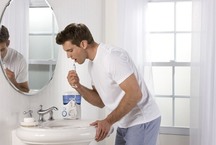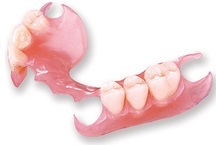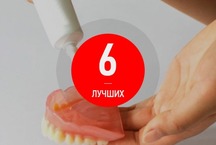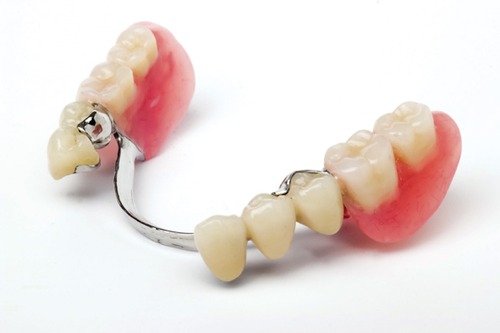
Byugelnaya is called the construction of which serves as a solid arc, on it are located the plastic base of the prosthesis (base) with artificial teeth. This type of prosthetics has been popular for a long time, it is an alternative in cases when the installation of implants is impossible.
Making of bagels is shown for various defects of the dentition, one of the important conditions is the presence of at least four abutment teeth. These prostheses are aesthetic, durable and easy to adapt and use, which brings them to the first place among all types of removable structures.
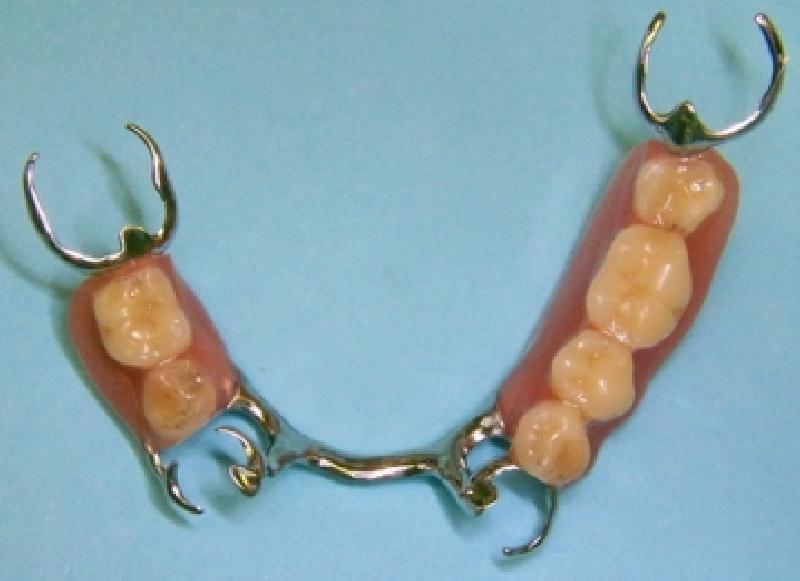
Advantages and disadvantages of clasp dentures
The main advantages of the clasp dentures
- Aesthetics - dentures with locking fastening, as well as those that are fixed on telescopic crowns, fully restore the aesthetics of the dentition.
- Durability - due to a small, compared to other types of removable prosthetics, the load on bone tissue and gums, they atrophy much slower, which allows you to wear dentures longer without replacement.
- Convenience - a thin arc and reliable fixation allow you to quickly adapt to the prosthesis, during use it does not fold, does not change the speech, completely restores the chewing function.
- Durability - since the basis of the prosthesis is a solid cast arc, the possibility of its failure is minimal.
- The ability not to take off for the night - it is only necessary to remove the dentures for their hygienic care.
- The combination of restoring the dentition and the treatment of periodontal disease (splinting prostheses).
Adaptation features
In contrast to plastic or nylon prostheses, the period of adaptation to the byugel is only a few days. From the first day of wearing a person does not suffer from changes in speech and lack of taste of products. Dentures are simple to install, and hold very securely. How to install the structure in the oral cavity, remove it and it is easier to get used to the doctor will tell during the last visit.
The disadvantages of clasp dentures
- high price;
- with a clasp mount, aesthetics are reduced;
- can not be installed in the absence of teeth (abutment teeth must be at least 4 on each jaw).
Indications and contraindications to the installation of a byugelnoy structure
TO main indications to install the clasp dentures include:
- presence of included and end defects of the dentition;
- unilateral defect;
- defects of the dentition in the presence of periodontal disease.
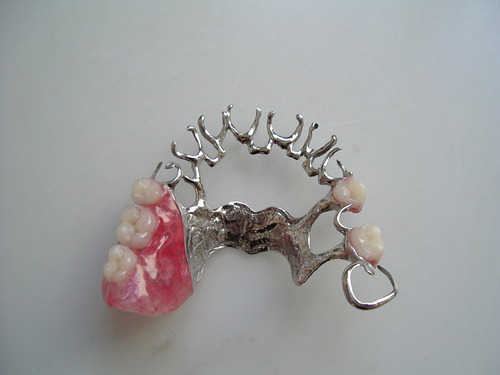
Contraindications:
- less than four abutment teeth;
- low crowns of remaining teeth;
- late stages of periodontal disease.
Types of bugel constructions
The table shows the main average prices and the possible durability of all existing types of bügels. The service life of the byugel structure can vary depending on the condition of the tissues of the oral cavity (with periodontal disease, the bone tissue and gum atrophy much faster) and care for the prosthesis itself. The cost of the prosthesis depends on the design, material and clinic (in some clinics byugel are an order of magnitude more expensive than the prices below).
|
№ |
View prosthesis |
Price |
Durability |
|
1. |
Simple denture with clamp on |
15 to 25,000 |
4-5 years |
|
2. |
Composite prosthesis with fastening on clamps |
25 to 30,000 |
4-5 years |
|
3. |
Splinting design |
From 30,000 |
3-4 years |
|
4. |
Telescopic crown construction |
Due to the complexity of manufacturing, the cost of construction increases 40-50000 |
|
|
5. |
Simple prosthesis with locking fixation |
From 45 to 55000 the price includes 4 metal-ceramic crowns and lock fastenings |
5-7 years |
|
6. |
Complicated prosthesis with locking fixation |
Over 55,000 |
5-7 years |
|
7. |
One-sided prosthesis with locking fixation |
From 35 to 45000 the price includes two metal-ceramic crowns and attachments |
5-7 years |
|
8. |
Design with arc of gold-platinum alloy |
The cost depends on the method of attachment and ranges from 75000 |
7-10 years |
Classification byugelnyh prostheses on the manufacturing material
Depending on the material from which the prosthesis is made, the following can be distinguished:
- Metal free byugelny designs (a prosthesis quadratti) - the arch in such artificial limbs is made of very strong pressed plastic or ceramics, they suit people suffering an allergic reaction to metal. Such designs are more fragile, therefore, they have less wear time and a greater risk of damage to the prosthesis.
- Bugeli with chrome-cobalt alloy arc - highly reliable due to the fact that they have a solid metal frame. Metal-ceramic crowns are included in the arc of prosthetic fastenings with locking fixation.
- Constructions where instead of a chromium-cobalt alloy for the manufacture of the arc and caps of metal-ceramic crowns is used gold platinum - The most expensive, do not cause allergies.
Byugel classification by fixing method
There are the following types of bugel constructions:
- byugel dentures with klammmernoy fixation - simple, complex and splinting;
- with lock fixing - bilateral and unilateral;
- fixed on telescopic crowns.
Clasp fixation byugel prostheses
A metal band is a tightly covering metal tooth in the widest place. Under the clasp prosthesis, it is desirable to cover the abutment teeth with artificial crowns (solid-molded or metal-ceramic). In addition to fixing clammer performs the support function, helping to distribute the chewing load between the teeth and mucous membrane (ideally, it is distributed in a ratio of 1: 3).
The main disadvantage of this type of construction is low compared with other aesthetics (the metal of the clasper can be seen in a smile and during a conversation). Since the clasps are cast together with the arc (this is a solid-cast construction), the risk that they will break is minimal.
A patient with a diagnosis of periodontal disease can suggest a splinting structure, due to which the mobility of the teeth is reduced, the chewing function and appearance are restored. Its differences consist in an additional arc located on the inner side of the prosthesis.
Prostheses with locking fixation (on attachments)
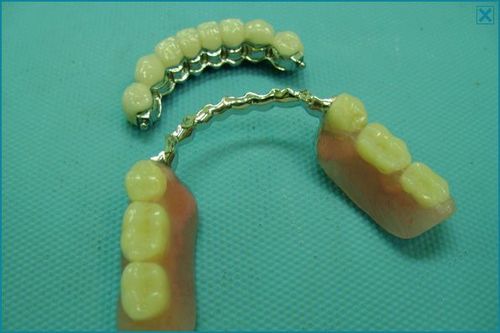
An attachment or lock is a structure consisting of two parts, one of which is fixed in the prosthesis, and the second in the metal-ceramic crown of the abutment tooth. When putting on the prosthesis, the parts are combined, which guarantees high reliability of fastening. With this type of prosthesis, the period of wearing the prosthesis is extended because the load on the mucous membrane and teeth is distributed in a ratio (1: 1). The main drawback is quite high prices.
Telescopic mounting of clasp prosthesis
In our camp, this type of prosthetics is used quite rarely due to the complexity of manufacturing the prosthesis. Fixation of the prosthesis takes place with the help of two crowns tightly interconnected (one is fixed on the supporting tooth, and the other is included in the frame of the prosthesis).
Stages of making partial denture
We can distinguish the clinical stages of the manufacture of the prosthesis and laboratory. Before making a bluella design, a complete reorganization of the oral cavity is necessary (treatment of dental diseases, removal of teeth, hygiene procedures).
Production steps:
- Clinical - examination, development of a treatment plan and its implementation, its duration depends on the dental problems of the person.
- Clinical - the preparation of abutment teeth and the removal of an impression for the manufacture of an individual impression spoon will take 1-2 hours (one visit to the doctor).
- Laboratory - making impression spoons - from 2 hours to 2 days depending on where the laboratory is located.
- Clinical - taking impressions for the manufacture of the prosthesis - 2 impressions are required from each jaw, the stage will take up to an hour (one visit to the dentist).
- Laboratory - making a plaster model of the jaw, creating a sketch and wax model of the prosthesis arch, making a heat-resistant mold, casting a skeleton, making a denture base from wax and installing artificial teeth on it. This stage can take from 4 to 10 days depending on the laboratory.
- Clinical - fitting frame with a wax base, takes up to one hour (one visit).
- Laboratory - replacement of wax with plastic, grinding and polishing the prosthesis, takes 1-3 days.
- Clinical - installation of the prosthesis in the patient's oral cavity, adjustment, lasts up to 2 hours (one visit).
Making a partial denture takes 4 visits to the dentista (we exclude those visits which fall at the preparatory stage). By the time it can make from 7 to 20 days depending on the clinic. In some clinics, the stages from the second to the fourth are done in one visit, you just have to wait a bit.
Care of a byugelny design
Caring for the denture dentures is simple:
- it is necessary to remove and clean them from food debris at least twice a day (you can brush with ordinary toothpaste, or you can purchase a special denture cleaner);
- In order for the clasp prostheses to serve for a long time, it is necessary to visit the dentist twice a year for professional treatment and consultation.
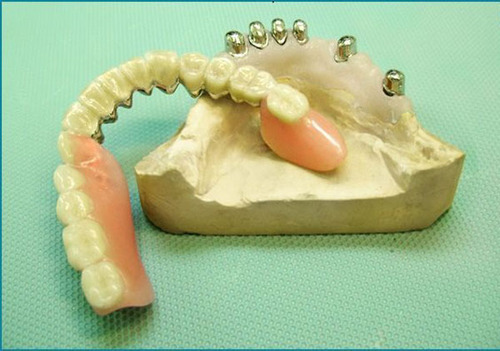
Repair byugelny designs
Clasp constructions are very durable, the failure of prostheses are found in just 10 people out of a hundred.
What to do if you have problems with prosthesis:
- breakdown of the cast frame - requires the manufacture of a new prosthesis;
- arc fracture also requires the manufacture of a new design;
- erased or lost teeth are replaced within one to two days;
- foundation cracks can be fixed in the presence of a person;
- relocation is required if the prosthesis ceases to fit snugly to the gum and is performed within 1-2 days;
- A lock or clasp is broken within 2 days.
It should be noted that if the warranty period (usually it is one year) has not passed, the repair is free; and if it is over, the repair will have to pay.
Patient testimonials about bugel prostheses
Anna 32 years - At a rather young age I lost my sixth tooth, for a long time I could not decide what to do. My dentist advised to install a partial clasp construction on the lock mount, which I did already 7.5 years ago. Since then, I have forgotten that such problems with chewing and smiling, the only inconvenience is that the prosthesis has to be taken out and washed.
Ivan is 65 years old - When choosing a clasp prosthesis, I decided to put myself with clasps, aesthetics were not particularly needed. I was completely satisfied, because I can eat everything, even solid products, the prosthesis does not fall out, does not click when talking like friends. In general, the money spent is not in vain.
Inga 44 years - It so happened that by the time I was 40, I was left with almost no lower teeth, after listening to my employee I decided to install a clasp prosthesis. The abutment teeth allowed the prosthesis to be installed on telescopic crowns, it is more expensive, of course, but it fully restored my smile. Finally all the complexes have disappeared and I can calmly talk and smile.

